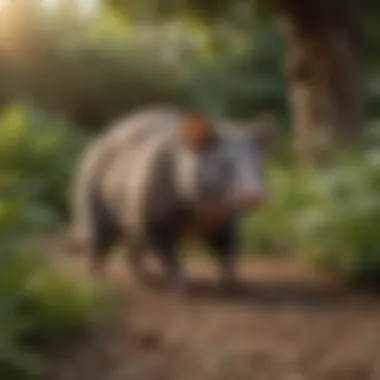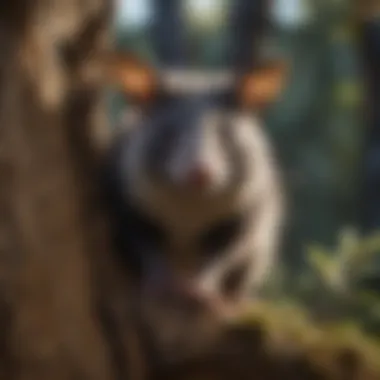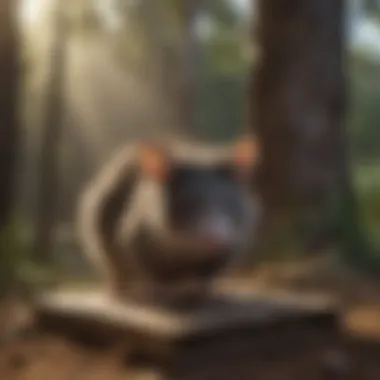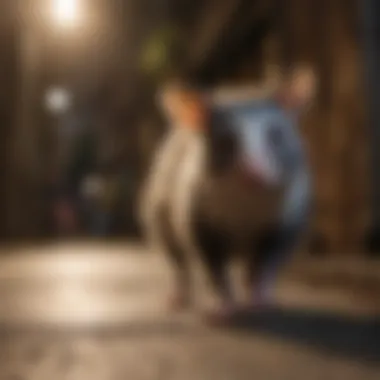Effective Strategies to Deter Possums: A Comprehensive Guide


Intro
Understanding how to effectively deter possums is essential for homeowners and residents. These nocturnal marsupials can become significant nuisances when they invade spaces meant for human habitation. Their presence can lead to property damage, disrupt peace, and even pose health risks. Therefore, developing a comprehensive strategy to manage possum interactions is not just practical; it's necessary.
To combat the issues presented by possums, we can explore various effective deterrent strategies. This guide not only addresses the identification of these creatures but also delves into prevention measures and treatment options. We will discuss how to recognize possum behaviors, establish humane deterrents, and consider ethical practices in managing wildlife. This clarity is vital for fostering a respect for nature while ensuring our living spaces remain safe and comfortable.
Now, let’s proceed further into Pest Identification.
Preamble to Possums
Understanding possums is crucial for managing their presence effectively in residential areas. This section aims to provide insights into their biology and behavior, as well as address some common misconceptions surrounding these marsupials.
Possums can often become unwelcome guests in our gardens and homes, leading to frustration and a desire for control. This guide will help readers appreciate the complexity of possum behavior and the reasons behind their invasions. Knowing how they behave assists in creating effective strategies to deter them, ensuring that properties remain safe and undisturbed.
Biology and Behavior
Possums are marsupials native to various regions, notably Australia and nearby islands. There are different species, with the common brushtail possum being one of the most recognized. They have a unique physical structure, including a prehensile tail that helps them climb and navigate their arboreal habitat.
Possums are nocturnal, mainly active at night. Their diet consists of fruits, leaves, and sometimes insects. Understanding their feeding habits helps identify food sources that may attract them to residential areas. Additionally, possums have a habit of marking their territory with scent, which makes it easier to determine where they may be frequenting. Overall, recognizing these traits is the first step in developing effective deterrence methods.
Common Misconceptions
There are many misconceptions about possums that can lead to ineffective management strategies.
- Possums are dangerous and aggressive. This notion is false; possums typically avoid confrontation and will often play dead when threatened.
- Possums carry rabies. Unlike some other wildlife, possums have a low likelihood of carrying rabies due to their thermoregulation, which makes them less hospitable to the virus.
- All possums are pests. While they can be troublesome when they invade spaces, they also play a role in the ecosystem, such as controlling insect populations.
Understanding these myths can reduce fear and promote more humane, effective practices for managing possum populations around homes.
Assessing the Problem
Assessing the problem of possums in residential or commercial spaces is a crucial step in developing effective strategies for deterrence. To manage these nocturnal marsupials, one must first recognize the signs of their activity and understand what attracts them to certain environments. An accurate assessment allows homeowners to implement targeted solutions that reduce the likelihood of possum intrusion, thereby promoting a more sustainable living situation.
Signs of Possum Activity
Recognizing the signs of possum activity is essential for homeowners. Possums are generally quiet, but they do leave behind indicators of their presence. Some common signs to look for include:
- Tracks: Possum tracks can often be seen in soft ground or dirt. The footprints are typically about five centimeters long and have a unique, somewhat rounded shape.
- Scat: Droppings are another clear sign of possum presence. Their scat is dark brown or black, often resembles small pellets, and can vary in size based on diet.
- Nests: Look for signs of nesting in low shrubs or tree hollows. Possums may use these spaces for shelter, especially if they feel safe and undisturbed.
- Feeding Damage: Possums might feed on pet food left outside, fruits from ornamental plants, or even vegetables from gardens. Chewed fruit or damaged plants can signal their presence.
It is vital to note these signs promptly. The sooner you identify potential possum intrusion, the easier it may be to deter them, preventing more serious issues down the line.
Identifying Attractants
To effectively manage possums, identifying what attracts them to your property is vital. Possums are opportunistic feeders and tend to be drawn to accessible food sources. Noting and eliminating these attractants will significantly reduce the likelihood of possums becoming a problem. Common attractants include:
- Pet Food: Leaving pet food outside can lure possums. Storing food indoors and feeding pets only when they can consume it all in one sitting may help.
- Garbage: Open trash cans are an open invitation for possums. Ensure garbage is secured in sealed containers and disposed of regularly.
- Fruits and Vegetables: If you have fruit trees or vegetable gardens, ripe and fallen produce can easily attract possums. Regularly harvesting fruits and vegetables can minimize this risk.
- Compost Bins: Compost can also draw in possums. Use proper composting techniques and consider the types of materials you add.
Understanding both the signs of possum activity and what attracts them creates a solid foundation for establishing an effective management approach. By being proactive, homeowners can maintain a possum-free environment while respecting the ecological role of these creatures.
Environmental Modifications
Environmental modifications play a crucial role in managing possum presence. These changes are aimed at altering the habitat and its attractions for possums, effectively reducing their appeal to invade residential and commercial properties. By adjusting the environment, homeowners can create a less hospitable atmosphere for these nocturnal creatures.
One major benefit of environmental modifications is their long-term efficacy. Unlike temporary deterrents, these strategies can lead to a sustained decrease in possum visitation when correctly implemented. Additionally, modifying the environment promotes a more harmonious coexistence with local wildlife, respecting the balance of nature while also safeguarding human interests.
Conversely, applying these modifications requires careful planning. It is essential to consider the specific characteristics of your property and the surrounding environment. Simple actions, like proper waste management and vegetation control, can have significant impacts on reducing possum attraction.


Securing Food Sources
Securing food sources is a fundamental component of environmental modifications. Possums are notorious scavengers, and their presence can often be attributed to easy access to food. Homeowners must take proactive steps to ensure that food is not readily available. Simple practices include securing garbage bins, cleaning up pet food remains, and managing compost properly.
This does not mean eliminating all food sources; rather, it involves making it more challenging for possums to find meals. Properly sealing trash containers, using animal-proof feeders, and avoiding food scraps in gardens can effectively diminish the allure that draws possums in.
Creating Barriers
Creating barriers serves as another effective method to deter possums. These barriers can physically prevent possums from accessing specific areas where they might cause trouble. This approach combines various techniques designed to create obstacles in possessive paths.
Fencing Options
Fencing options are a widely adopted solution for managing possums. By constructing a secure fence, homeowners can limit possums' access to gardens and yards. The key characteristic of effective fencing is height and material. A minimum height of 1.8 meters is suggested to deter possums successfully. Using solid materials and ensuring the fence is buried at least 30 cm underground discourages burrowing attempts.
However, the type and condition of the fence play significant roles in its effectiveness. For instance, chain-link fencing may not be as effective as wood or vinyl due to potential gaps. Careful consideration of a fence’s design and location can result in a beneficial addition to a home’s defense against possums.
Natural Barriers
Natural barriers involve using existing vegetation or strategically planting shrubs and trees to discourage possum movement. This method is beneficial because it utilizes nature's own resources to create obstacles., while also enhancing the aesthetics of the property. Dense shrubs can act as a deterrent as they present an unsuitable environment for possums.
One unique aspect of natural barriers is their dual functionality. They not only provide a physical block but can also contribute to local biodiversity and enhance landscape beauty. However, these barriers may take time to establish, which can be seen as a disadvantage in urgent situations. Nevertheless, with the right planning, natural barriers can serve as a sustainable strategy in the long-term management of possums.
"Environmental modifications are essential for homeowners wanting to maintain a possum-free zone without harming local wildlife."
By understanding and implementing a range of environmental modifications, homeowners can achieve a significant reduction in possum activity while also fostering a more sustainable living environment.
Deterrent Techniques
In the pursuit of keeping possums away from residential and commercial spaces, understanding and implementing various deterrent techniques is essential. These techniques serve not only to prevent possums from invading properties but also to ensure that any measures taken are humane and respect wildlife. By using a combination of natural, electronic, and chemical deterrents, homeowners can create an environment that is less appealing to these creatures.
Properly chosen deterrents can lead to effective results. Homeowners should keep in mind that each technique has its benefits and considerations. It is vital to assess the specific circumstances of your property and possum behavior to identify which strategies are most suitable. Additionally, combining methods can enhance their overall effectiveness.
Natural Repellents
Natural repellents are often the first line of defense in deterring possums. They are typically safe for use around children and pets, making them favorable for many households. Common natural repellents include:
- Garlic: The strong smell of garlic is known to ward off several kinds of wildlife, including possums. Sprinkling garlic powder or using garlic essential oil around the garden can help.
- Pepper: Similar to garlic, strong spices can create an uncomfortable environment for these animals. Cayenne pepper or black pepper spread around potential entry points might deter them.
- Predator Urine: The scent of predator urine, available commercially, can signal danger to possums, making them likely to avoid treated areas.
These methods may not guarantee complete removal from the property, but they can significantly reduce the chances of possum visitation. Homeowners should apply these regularly, especially after rain or heavy winds, as moisture can wash away scents.
Electronic Deterrents
The rise of technology has led to the development of electronic deterrents that can effectively keep possums away. These devices often combine sound and light to create an unpleasant environment for wildlife. Key electronic options include:
- Ultrasonic Repellers: These devices emit high-frequency sound waves that are inaudible to humans but disturb possums and other nuisances, encouraging them to leave the area.
- Motion-Activated Lights: Bright lights triggered by motion can startle possums, making nighttime visits less appealing. This method is particularly effective for property owners with gardens or outdoor spaces that are frequently visited by these animals.
The use of electronic deterrents provides a long-term solution without the need for constant monitoring, unlike some natural repellents. However, it is important to consider placement and ensure that devices cover the areas most prone to possum activity.
Chemical Deterrents
While natural and electronic options are valuable, some may seek additional methods through chemical deterrents. These products usually contain substances that create bad odors or tastes that possums find intolerable. Here are some common chemical deterrents:
- Commercial Repellents: Various commercial products are specifically designed for deterring possums. They often include potent scents or formulations that make specific areas unattractive to these animals.
- Bittering Agents: Spraying a solution with a bitter taste on plants may make them less appealing to possums and other critters. This method will protect vegetation without harming the animals.
Despite their potential effectiveness, it's prudent to apply chemical deterrents judiciously. Overuse could lead to environmental harm or undesirable reactions from pets and other wildlife. Homeowners should read labels carefully and choose products that are designated as safe for use in residential areas.


Using a combination of natural, electronic, and chemical deterrents can create a comprehensive strategy to keep possums away while ensuring humane practices are followed.
Humane Trapping Methods
Humane trapping methods play a critical role in managing possums effectively. These techniques prioritize the well-being of the animal while addressing the concerns of property owners. They provide a solution that can be both effective and ethical. Implementing humane traps ensures that possums are not harmed and can be relocated safely. It's essential to choose methods that comply with regulations and emphasize that these animals will be treated with respect.
Best Practices for Trapping
Using best practices in humane trapping is vital for success. Here are some important points to consider:
- Right Equipment: Invest in high-quality traps designed specifically for possums. These traps should be large enough for an adult possum but also secure to prevent escape.
- Proper Baiting: Baiting should be done with care. Use foods that possums are attracted to, such as fruits or vegetables. A banana or sweet potato can work well as bait.
- Placement of Traps: Place traps in areas where you have seen signs of possum activity. Look for footprints, droppings, or gnaw marks to find optimal locations.
- Check Traps Regularly: Traps must be checked frequently. This action is essential to minimize stress on the captured animal and provide timely relocation.
- Avoid Use of Poisons: Poisons can pose significant risks not just to the target species but also to other wildlife and pets. Stick with humane trapping methods.
By following these best practices, property owners can carry out possum trapping effectively without causing unnecessary harm to the animals.
Relocation Considerations
When it comes to relocating a trapped possum, several factors must be taken into account. First, ensure the relocation site is suitable for the animal. Here are key points to ponder:
Legal Guidelines
Understanding legal guidelines is crucial in humane trapping and relocation. Different regions may have specific laws governing the capture and relocation of wildlife. These regulations often stipulate:
- Permits and Licenses: Some areas require permits to trap and relocate possums legally.
- Prohibition Against Releasing Indoors: Many jurisdictions state that possums cannot be released within residential areas or urban environments.
- Identification of Suitable Locations: Ensure that the release site is appropriate and far enough from human activity.
It is important to be aware of local laws. Complying with legal frameworks not only respects ethical standards but also avoids potential penalties.
Ecosystem Impacts
Ecosystem impacts from relocation efforts should not be overlooked. Relocating possums can have various effects on the environment:
- Disruption of Local Populations: Introducing a new animal to an area can disturb existing ecosystems. It may lead to competition for resources with local wildlife.
- Habitat Suitability: When choosing a relocation site, ensure it has the right resources such as food and shelter for the possum to survive.
- Reproductive Concerns: Moving possums to new areas may disrupt their mating habits or cause stress, which could influence their reproduction.
Evaluating ecosystem impacts is essential to ensure that humane trapping and relocation methods benefit both the possum and the environment. By using humane practices and understanding the implications of relocation, homeowners can take responsible steps in addressing possum issues.
Long-Term Possum Management
Long-term possum management is a critical aspect when addressing issues related to possum presence in residential and commercial settings. This sustainable approach goes beyond mere deterrence techniques and into fostering an environment that minimizes possum attraction and residence. Implementing effective long-term strategies can prevent future invasions while ensuring that human-wildlife coexistence remains respectful and balanced.
The essence of long-term management is rooted in understanding possum behaviors and modifying the environment accordingly. By tackling the root causes for possum attraction, homeowners can create consistent measures that discourage possums from considering their property a viable habitat. In addition, adopting these strategies often results in less reliance on chemical deterrents or traps, which can be harmful to both the possums and other local wildlife.
Behavior Modification Strategies
Behavior modification in possums focuses on altering how they interact with their environment. This may involve habitat changes to make areas less appealing to these animals. For instance, consistently removing food sources is vital. Possums are opportunistic feeders, drawn to easily accessible food waste.
- Secure Garbage Bins: Ensure that all waste containers are sealed tightly. Consider using bins with secure lids that can’t be easily opened.
- Remove Pet Food: Do not leave pet food outside, as it can attract possums. Keep feeding areas clean after pets are done eating.
- Limit Access to Gardens: Planting strong-smelling herbs like rosemary and mint around gardens can deter possums naturally, as they may find the scents overwhelming.
Further, if landscaping can be altered to reduce shelter options, it can deter possums from settling. This includes trimming low hanging branches and clearing underbrush that may serve as hiding spots. By modifying habitat structures, you change the framework within which possums operate, effectively decreasing their likelihood of returning.
Community Engagement
Community involvement is equally vital in long-term possum management. When entire neighborhoods work together, the effectiveness of deterrent strategies multiplies. Sharing information about possum behavior and successful strategies helps others in the community take proactive measures.
- Organize Workshops: Creating awareness through educational events can inform your community on effective possum management practices.
- Collaborative Clean-Up Days: Organizing group clean-up efforts to clear debris and food sources in shared spaces can help deter possums from aggregating in the area.
- Share Resources: Use platforms like Facebook or Reddit to communicate strategies and solutions. Sharing links to articles or studies about possums can enlighten others.
By fostering a culture of proactive management, communities can reshape their environments collectively. It demonstrates how a few dedicated individuals can successfully reduce the possum presence, creating safer, more pleasant living spaces for everyone.


Long-term management not only addresses existing issues but also empowers communities through shared responsibility.
When to Seek Professional Help
In managing possums, understanding when to seek professional help is crucial for effective control. Do-it-yourself methods can work well for minor issues. However, there are times when the situation escalates beyond personal capability. Professional pest control services bring expertise, tools, and strategies that could be essential for serious infestations. Relying on professionals is often a safe and effective choice to ensure responsible management of wildlife.
Signs of a Larger Infestation
Recognizing the signs of a larger infestation is key to determining whether professional help is needed. Some potential indicators include:
- Frequent Sightings: Seeing multiple possums during the night suggests an established population.
- Noise Disturbances: Persistent noises from walls or ceilings, especially during night, signify nesting activity.
- Damage: Chewed wood, torn screens, or disturbed insulation often point to extensive activity.
- Droppings: Finding a significant amount of possum droppings can indicate regular visits.
If one or more of these signs appear, it could be time to contact a pest control expert. Acting quickly can prevent further damage and complications.
Choosing the Right Pest Control Services
Selecting suitable pest control services is an important decision. Factors to consider include:
- Experience: Choose companies with a solid reputation in managing wildlife. Look for reviews or case studies.
- Techniques Used: Ensure the methods are humane and sustainable. Avoid services that promote lethal control as the main solution.
- Licensing and Certifications: Verify if the pest control operators are licensed and comply with local regulations.
- Follow-up Services: It is beneficial to find services that include follow-up assessments to ensure possums do not return.
Working with the right professionals will help safeguard your property while respecting the ecological balance. By being informed and prepared, homeowners can take steps to manage possum activity effectively.
Legal and Ethical Aspects
The management of possums involves important legal and ethical considerations. It is crucial for homeowners and property managers to understand the implications of their actions in relation to wildlife. Not only does this establish a framework for responsible behavior towards these animals, but it also helps avoid potential legal issues. As urban areas expand, encounters between possums and humans increase. Therefore, it is paramount to be informed about laws and ethical standards that govern wildlife interactions.
Understanding Local Wildlife Laws
Numerous regions have specific laws regulating how people can manage possums and other wildlife. These laws often vary based on location, which means homeowners must stay informed about their local regulations. Common legal aspects include:
- Trapping Guidelines: Certain jurisdictions only allow humane trapping methods. Using traps that cause harm or suffering could lead to legal repercussions.
- Relocation Rules: Moving possums away from property to another area might not be permitted in some regions. Regulations often require that wildlife remains in their natural habitat to prevent ecological disruption.
- Permits: Some areas may require permits for specific wildlife management activities. Familiarizing with these rules can help avoid fines or other legal complications.
Being aware of these laws promotes not only compliance but also respect for the ecosystem. This understanding helps to foster a sustainable approach to managing wildlife presence.
Ethics of Wildlife Management
Ethical considerations in wildlife management aim to ensure that our actions are humane and environmental-focused. Owning property should not come at the expense of other living beings. Here are some critical points to consider:
- Humane Treatment: Possums, like all wildlife, deserve humane treatment. Practices that cause unnecessary suffering or harm contradict ethical wildlife management.
- Balancing Interests: It is essential to consider the balance between human needs and animal welfare. This includes understanding why possums are attracted to certain environments and addressing those reasons proactively.
- Sustainable Solutions: Solutions should aim for long-term effectiveness rather than short-term fixes. This includes ongoing education around possum behavior, which fosters coexistence instead of conflict.
The ethical stance of wildlife management highlights our responsibility as stewards of the environment.
Engaging with these ethical principles leads to better management strategies that respect all species involved. A responsible approach creates a peaceful, cohabitative space where both humans and possums can thrive.
Culmination
In this article, we have detailed various effective methods and strategies for keeping possums at bay from residential and commercial properties. Understanding the behavior of possums is essential for effective management. By recognizing their habits and the attractants that draw them near, homeowners can take proactive measures from the outset.
Summarizing Effective Methods
Summarizing the effective methods discussed, environmental modifications are crucial. Simple changes like securing food sources and creating physical barriers contribute significantly to preventing possum access. Utilizing natural and electronic deterrents plays a role in making areas less inviting for these animals.
Another point to highlight is the importance of humane trapping and relocation practices. Trapping should always be carried out with the utmost care for the animals. Following best practices ensures not only compliance with legal guidelines but also considers the ecological impacts of relocation.
Encouraging Sustainable Practices
Encouraging sustainable practices is an aspect every homeowner should consider. Engaging with the community on wildlife management fosters a collective responsibility toward maintaining a balance with nature. This encourages methods that are not only effective but also environmentally conscious.
Utilizing non-toxic repellents and fostering native vegetation can help create a more harmonious environment. These strategies not only deter possums but also support local wildlife and promote biodiversity.
By focusing on humane and sustainable methods, communities can address possum presence effectively while respecting the environment and local regulations.



